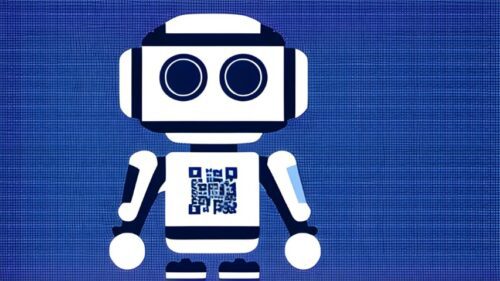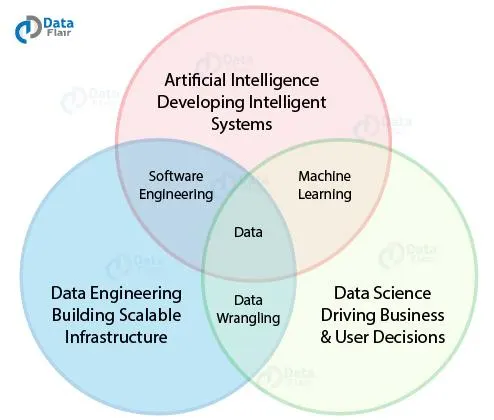Artificial Intelligence and Data Science: 7 Definitive Facts
Introduction
In the dynamic landscape of the digital era, the triumvirate of Data Engineering, Data Science, and Artificial Intelligence has reshaped trouble-fixing paradigms. These technologies, targeted around statistics, have revolutionized human trouble interpretation and determination. Although awesome in their programs, Data Science and Artificial Intelligence proportion complicated correlations, with the latter closely reliant on the harmonious partnership with Data Engineering. As these fields surge ahead with continuous advancements, they’re poised to usher inside the fourth commercial revolution, for all time altering the enterprise’s cloth.
The Interwoven Nature of Data Engineering, Data Science, and Artificial Intelligence
At the core of this transformative adventure lies Data Engineering, which undertakes the crucial challenge of gathering, organizing, and refining data to make it ready for intake. Its function is necessary as it lays the muse for the subsequent tiers. Working hand in hand, Artificial Intelligence in Data Science takes the middle stage, leveraging meticulously prepared statistics to force technological automation and intelligence. This symbiotic dating is pivotal because the prowess of Artificial Intelligence is found best while empowered by the seamless drift of curated records.
Data Science, functioning as the middleman, capitalizes on the prepared information to expect, examine, and extract valuable insights. Its predictive and analytical talents not only decipher complicated patterns but also guide knowledgeable choice-making. Artificial Intelligence, on the other hand, emerges as the fruit of this adventure, employing sophisticated equipment to craft intelligent structures that could autonomously procedure and interpret facts, mimicking human-like cognitive capabilities.
The Nexus of Similar Objectives
Although distinct in their methodologies, Data Science and Artificial Intelligence converge to gain analogous effects focused on records analysis. Both disciplines harness the power of facts to unravel insights that force innovation, optimization, and strategic planning. Data Science, through its predictive modeling and statistical analysis, unveils hidden developments, enabling agencies to make knowledgeable selections. Artificial Intelligence, via processing considerable datasets and the usage of superior algorithms, allows the advent of wise answers, starting from chatbots to self-riding motors.
A Glimpse into the Benefits and Types
Data Science and Artificial Intelligence provide a large number of benefits throughout industries. Data Science empowers groups to beautify consumer stories, optimize operations, and forecast market developments. Meanwhile, Artificial Intelligence enriches the landscape with computerized selection-making, personalized hints, and efficient useful resource allocation. Both methodologies gas innovation and competitiveness, marking their indispensability within the contemporary global.
In phrases of kinds, Data Science encompasses descriptive, predictive, and prescriptive analytics. Descriptive analytics elucidates beyond occurrences, predictive analytics foretells destiny trends, and prescriptive analytics recommends movements. Similarly, Artificial Intelligence is assessed into slender and trendy AI. Narrow AI excels in precise obligations, while fashionable AI strives to replicate human intelligence comprehensively.
A Comparative Analysis
Three key elements delineate the nuanced differences between Data Science and Artificial Intelligence. While Data Science usually includes extracting insights from records, Artificial Intelligence is greater centered on growing smart structures. Data Science’s sphere extends to exploratory evaluation, statistical modeling, and visualization, while Artificial Intelligence delves into machine getting-to-know, neural networks, and natural language processing. Furthermore, Data Science fuels knowledgeable decision-making, whilst Artificial Intelligence is geared towards automating responsibilities and enhancing human-like cognitive tactics.
The confluence of Data Engineering, Data Science, and Artificial Intelligence is steering the virtual technology towards unheard-of territories. Their interdependence is the cornerstone of sensible automation and insightful decision-making. As the era hurtles ahead, the evolution of those disciplines guarantees to redefine industries, propel innovation, and reshape human interactions with the virtual realm. With the fourth commercial revolution on the horizon, the synergy between Data Science and Artificial Intelligence stands as a testament to the exceptional abilities of human ingenuity.
What is Artificial Intelligence?
Artificial Intelligence, generally known as AI, is a discipline of PC technological know-how that makes a specialty of growing structures and technologies capable of acting on responsibilities that usually require human intelligence. These responsibilities encompass a wide range of activities, inclusive of hassle-fixing, choice-making, gaining knowledge from studies, spotting styles, information herbal language, or even showing creativity. AI pursuits to broaden PC applications and machines that could simulate human cognitive features, enabling them to method information, make informed picks, and adapt to changing occasions. Through the usage of algorithms, records evaluation, and superior techniques, AI systems can reflect human-like questioning approaches, mainly to the automation of complicated obligations and the development of wise solutions.
Artificial Intelligence and Data Science
Types of Artificial Intelligence
Delving into the intricate tapestry of artificial intelligence brings forth a taxonomy of classifications that warrant deeper exploration. These classifications, delineated below, elucidate the nuanced nature of AI’s multifaceted manifestations:
- Artificial Narrow Intelligence (ANI): Positioned as the bedrock of artificial intelligence’s stratification, ANI embodies a fundamental facet. These intelligent systems are meticulously engineered to tackle a solitary problem with surgical precision. Their competence, while confined to a specific niche, is marked by exceptional acumen within a controlled milieu defined by well-defined parameters.
- Artificial General Intelligence (AGI): At the zenith of conceptual musings lies AGI, a notion that kindles visions of cognitive parity with humanity. AGI envisions an entity possessing a panoply of cognitive faculties spanning linguistic cognition, visual comprehension, and computational dexterity. The orchestration of AGI’s symphony demands the harmonious convergence of multiple ANI entities. Even when armed with the formidable computational arsenals exemplified by Fujitsu’s K and IBM Watson, the endeavor to replicate a solitary second of human neural dialogue requires an investment of a substantial 40 minutes, underscoring the chasm between computational might and the intangible aspirations of AGI.
- Artificial Super Intelligence (ASI): Ascending to the realm of speculative conjecture is ASI, the apotheosis of artificial intelligence theories. ASI posits an intelligence that not only eclipses the cognitive prowess of human contemplation but also thrives on perpetual adaptation, seamlessly juggling myriad tasks. Nonetheless, the present state of computational artifice has yet to surmount the threshold necessary to mirror the profundity of human cognition, relegating ASI to the realm of nascent hypotheses. While ASI inherits its theoretical essence from AGI, its crystallization into actuality remains an elusive mirage on the foreseeable horizon.
Purpose of Artificial Intelligence
In a state-of-the-art swiftly evolving virtual landscape, the integration of synthetic intelligence (AI) has come to be a cornerstone of innovation across diverse industries. The purpose of this text is to delve into the transformative capacity of AI, exploring its multifaceted programs, and blessings, and how it is shaping the future of corporations and societies.
Unveiling the Essence of Artificial Intelligence
Artificial Intelligence, regularly abbreviated as AI, is a sophisticated generation that endows machines with human-like cognitive capabilities. It allows computers to learn from enjoy, adapt to new inputs, and perform tasks that usually require human intelligence. AI features a spectrum of technology, which include device gaining knowledge of, herbal language processing, PC vision, and more. Its cause is to enhance efficiency, accuracy, and selection-making throughout various domains.
Applications Across Industries
AI’s wonderful versatility has brought about its integration into a wide range of industries, ranging from healthcare and finance to production and amusement.
- Healthcare
In the healthcare quarter, AI is revolutionizing diagnostics, drug discovery, and affected person care. Machine mastering algorithms can examine clinical pix, including X-rays and MRIs, to discover anomalies with high precision. Additionally, AI-powered chatbots provide personalized scientific recommendations and aid, improving patient stories.
- Finance
AI is reshaping the financial enterprise through algorithmic buying and selling, fraud detection, and customer service. Predictive analytics and statistics-driven insights allow monetary institutions to make informed decisions and control dangers more efficiently.
- Manufacturing
Manufacturing tactics have become greater efficient and adaptive with AI-driven automation. Robotics and AI-powered sensors collaborate to optimize manufacturing strains, decrease defects, and reduce operational fees.
- Entertainment
AI-driven content material recommendation systems are enhancing consumer studies in the entertainment sector. Streaming platforms analyze consumer choices to indicate relevant movies, suggestions, and music, catering to men’s or women’s tastes.
The Benefits of AI Adoption
The incorporation of AI gives a myriad of blessings that enlarge past operational performance. Some of the distinguished blessings include:
- Enhanced Productivity
AI automates repetitive responsibilities, permitting personnel to be conscious of better-fee activities that require creativity and essential questioning. This boosts usual productiveness and task pleasure.
- Data-Driven Insights
AI algorithms examine vast datasets to extract meaningful insights. Businesses can make nicely-informed selections based on correct predictions and trends identified via AI fashions.
- Three. Personalization
Through AI, organizations can deliver personalized stories to their customers. AI-powered recommendation engines tailor product tips and content, mainly to better purchaser engagement and satisfaction.
- Risk Management
In industries like finance, AI algorithms determine information in real-time to locate anomalies and ability risks. This proactive method minimizes fraudulent activities and economic losses.
Shaping the Future Landscape
The effect of AI on society and business isn’t always constrained to the prevailing. As the generation continues to conform, AI is poised to play an excellent more transformative function in shaping destiny.
- Autonomous Vehicles
AI-driven independent cars are set to revolutionize transportation. These cars use sensors, cameras, and superior algorithms to navigate roads properly, decreasing accidents and congestion.
- Healthcare Advancements
The healthcare zone will witness further advancements as AI assists in predicting ailment outbreaks, personalizing treatment plans, and accelerating drug discovery.
- Environmental Conservation
AI can make a contribution to sustainability efforts by means of optimizing electricity intake, predicting natural screw-ups, and assisting in flora and fauna conservation through statistics analysis.
- Ethical Considerations
As AI turns into a greater included in day-by-day existence, ethical concerns surrounding statistics privateness, bias mitigation, and task displacement require careful attention. Balancing innovation with moral standards is crucial.
Embracing AI for Progress
In conclusion, the reason AI transcends mere automation—it encompasses the elevation of industries, societies, and the satisfaction of human life. As agencies and people harness the potential of AI, they free up unprecedented opportunities for growth, efficiency, and innovation.
To learn more about Artificial Intelligence, click here
Unraveling the Depths of Data Science: A Comprehensive Guide
In the digital age, we discover ourselves entrenched in, statistics has become greater than only a buzzword. It’s the lifeblood that guides through the veins of every selection, innovation, and development. Welcome to our in-intensity exploration of Data Science, a subject that has hastily risen to prominence and is reshaping the way we understand statistics, make predictions, and revolutionize industries.
Defining Data Science
At its center, Data Science is an interdisciplinary field that amalgamates numerous techniques, algorithms, methods, and structures to extract precious insights and information from structured and unstructured information. By harnessing the energy of records, laptop technological know-how, area know-how, and gadget mastering, Data Science empowers agencies to find hidden patterns, developments, and correlations that could otherwise continue to be concealed in full-size facts sets.
The Pillars of Data Science
- Statistics and Probability Theory
Statistics is the spine of Data Science. It gives the tools to gain experience of information, perceive developments, and draw meaningful conclusions. The probability principle, on the other hand, helps quantify uncertainty and randomness in facts, which is vital for making correct predictions.
- Domain Knowledge
While algorithms and information manipulation are vital, knowledge of the context of the statistics is similarly crucial. Domain expertise ensures that the insights drawn from the information align with real international eventualities and cause actionable decisions.
- Programming and Data Manipulation
Proficiency in programming languages like Python, R, and SQL is a cornerstone of Data Science. These languages enable statistics scientists to manipulate, easily, and preprocess facts, putting the level for evaluation.
- Machine Learning
Machine Learning, a subset of artificial intelligence, empowers structures to examine records and improve their overall performance through the years without explicit programming. Techniques like supervised mastering, unsupervised gaining knowledge of, and deep gaining knowledge of have revolutionized industries from healthcare to finance.
- Data Visualization
Presenting complicated findings in a comprehensible way is in which records visualization comes into play. Visualizations, within the form of graphs, charts, and dashboards, aid in conveying insights to stakeholders efficaciously.
Demystifying the Life Cycle of Data Science: A Comprehensive Overview
In the realm of modern technology, in which records are generated at an unheard-of tempo, the field of Data Science stands as a guiding light to harness the ability of this records deluge. To simply recognize the prowess of information technology, one has to delve into its lifecycle, a systematic journey that transforms raw records into actionable insights. This complete manual pursuit demystifies the Life Cycle of Data Science, unraveling each level with precision and readability.
- Problem Definition and Understanding
At the coronary heart of every successful statistics technology endeavor lies a well-described problem. This initial stage involves participating carefully with stakeholders to articulate the hassle to hand and determine how statistics can offer answers. Clarity in hassle definition sets the trajectory for the whole records science procedure.
- Data Collection and Gathering
With the problem mentioned, the following step is to accumulate relevant facts. These statistics can come from a myriad of assets: established databases, unstructured textual content, pix, motion pictures, and more. The excellent of the statistics amassed plays a pivotal function in the accuracy and reliability of the next analyses.
- Data Cleaning and Preprocessing
Raw information is seldom prepared for evaluation. This level involves cleaning and preprocessing the facts to ensure their integrity. Missing values, outliers, and inconsistencies are addressed, and the statistics are transformed into a dependent layout appropriate for evaluation.
- Exploratory Data Analysis (EDA)
EDA is comparable to sifting through a treasure trove because it entails analyzing the facts to find styles, traits, and correlations. Visualization tools play a vital function in this stage, helping statistics scientists gain insights and formulate hypotheses for further exploration.
- Feature Engineering
Features are the building blocks of predictive fashions. Feature engineering involves selecting, reworking, and developing new capabilities from the present information to enhance the overall performance of machines gaining knowledge of algorithms. This level needs creativity and domain expertise.
- Model Selection and Training
Choosing the right model is important. Based on the character of the problem and the characteristics of the facts, facts scientists pick suitable algorithms. These algorithms are then educated using labeled statistics, letting them research styles and relationships.
- Model Evaluation and Tuning
After training, models are evaluated using validation techniques. Metrics like accuracy, precision, don’t forget, and F1 score are used to gauge performance. If necessary, fashions are first-class-tuned with the aid of adjusting hyperparameters to obtain the most advantageous outcomes.
- Model Deployment
A successful version isn’t restrained to the laboratory. Deployment entails integrating the version into actual-world packages, allowing it to make predictions on new, unseen statistics. This level calls for collaboration with software engineers and IT groups.
- Monitoring and Maintenance
Even after deployment, the adventure doesn’t give up. Models want to be monitored for performance degradation, shifts in information distribution, and other factors that could affect accuracy. Regular updates and upkeep are crucial to ensure persistent reliability.
- Communicating Insights
The end result of the records technology lifecycle involves offering the insights gained from the analysis. Effective verbal exchange is critical, as records scientists need to carry complex findings to non-technical stakeholders in a comprehensible manner.
Embracing the Data Science Journey
As the era advances and information proliferates, the lifestyle cycle of information technology stays consistent. It’s a journey that needs not only the simplest technical acumen but also creative wondering, hassle-fixing capabilities, and the capability to evolve to new challenges. Whether you’re a budding data scientist or an enterprise leader seeking to leverage information-driven insights, information on the intricacies of the facts technology lifestyles cycle is a stepping stone to fulfillment.
Applications of Data Science
The reach of Data Science spans far and huge, leaving no quarter untouched with the aid of its transformative prowess.
1. Business and Finance
In the sector of commercial enterprise, facts-pushed insights steer strategic selections. From marketplace analysis and customer segmentation to chance evaluation and fraud detection, facts and technological know-how enhance performance and minimize dangers.
2. Healthcare and Medicine
Data Science revolutionizes healthcare by permitting personalized remedy plans, drug discovery, ailment prediction, and even improving medical imaging for extra correct diagnoses.
3. Technology and Innovation
Tech giants appoint facts science to refine user reports, advocate merchandise, and develop speech and photo recognition, and energy-independent vehicles.
4. Social Sciences and Public Policy
Data-driven insights affect public coverage by providing proof for choice-makers. It aids in informing demographic traits, predicting social results, and formulating effective interventions
Artificial Intelligence and Data Science: Understanding the Relationship
In the dynamic landscape of facts science, one innovative force has emerged as a game-changer: Artificial Intelligence (AI). With its capacity to procedure and examine enormous amounts of information at first-rate speeds, AI has transformed the manner we extract insights, make predictions, and clear up complicated problems. In this complete guide, we delve into the complex courting between Artificial Intelligence and Data Science, uncovering its importance, applications, and implications for destiny.
Unveiling the Synergy: AI and Data Science
At the heart of modern-day records-driven choice-making lies the synergy among AI and Data Science. Data Science involves the collection, processing, and evaluation of records to discover precious insights and styles. Artificial Intelligence, then again, empowers systems to analyze this data and make shrewd selections. The amalgamation of those fields consequences in an effective symbiosis that propels organizations toward knowledgeable choices and innovation.
Applications of AI in Data Science
AI’s applications within the realm of Data Science are full-size and sundry, spanning across industries and domain names. Let’s explore a number of the outstanding applications:
1. Predictive Analytics: AI-pushed predictive analytics leverages historic facts to forecast destiny trends and outcomes. Organizations could make knowledgeable choices by awaiting purchaser behavior, market shifts, and resource needs. This functionality is precious for optimizing techniques and staying in advance in aggressive markets.
2. Natural Language Processing (NLP): NLP, a subfield of AI, specializes in permitting computer systems to recognize, interpret, and generate human language. In Data Science, NLP performs a vital role in sentiment evaluation, chatbots, and language translation. Its utilization empowers agencies to extract insights from textual statistics assets like social media, consumer critiques, and surveys.
3. Image and Video Analysis: AI’s prowess extends to photograph and video analysis, wherein it is able to apprehend styles, gadgets, and even feelings inside visual content. This is pivotal for industries that include healthcare (diagnostic imaging), self-sustaining vehicles (object recognition), and enjoyment (content material recommendation based on viewer reactions).
4. Anomaly Detection: Detecting anomalies in records is crucial across numerous sectors, consisting of finance, cybersecurity, and production. AI algorithms excel at identifying deviations from set-up styles, permitting organizations to rapidly deal with irregularities and mitigate risks.
The Road Ahead: AI-Driven Data Science Advancements
The trajectory of AI and Data Science is marked by way of non-stop evolution. As the era advances, so does the capacity for innovation inside this intersection. Here are a few thrilling avenues that lie in advance:
1. Enhanced Decision Support Systems: AI-pushed choice help structures become greater state-of-the-art, supplying real-time insights into useful resources in complex decision-making. These systems will draw from numerous facts and resources and offer actionable hints, making them fundamental in government boardrooms.
2. AI-Powered Automation: Automation will witness an enormous enhancement through AI integration. Data Science will gasoline the development of shrewd robots and automated tactics that can adapt to dynamic environments, main to higher efficiency and decreased operational fees.
3. Ethical Considerations and Bias Mitigation: With the growing reliance on AI in Data Science, addressing ethical concerns and biases will become paramount. The industry will be cognizant of creating transparent algorithms and frameworks that mitigate biases and ensure fairness in selection-making processes.
4. Augmented Data Analysis: AI will increase the competencies of facts analysts by means of automating recurring obligations and uncovering hidden insights in large datasets. Analysts can then recognize and interpret complex results and formulate techniques based on AI-generated tips.
In conclusion, the relationship between Artificial Intelligence and Data Science isn’t always merely symbiotic—it’s innovative. The infusion of AI’s cognitive skills into Data Science has transformed industries, better decision-making, and opened doorways to unparalleled innovation. Destiny holds even greater promise as those fields hold to adapt hand in hand, shaping a facts-pushed global powered via intelligence and insights.
Role of Artificial Intelligence in Data Science
In the ever-evolving landscape of statistics technology, Artificial Intelligence (AI) has emerged as a pivotal force, revolutionizing the way we procedure, analyze, and extract insights from great datasets. The symbiotic dating among AI and Data Science has unlocked new nation-states of opportunity, allowing organizations and researchers to make informed choices and find hidden patterns with exceptional precision.
Understanding the Synergy: The position of Artificial Intelligence in Data Science isn’t always certainly additive; it is transformative. Data Science involves gathering, organizing, and interpreting statistics to benefit insights into various phenomena. AI, however, empowers machines to examine these statistics, adapt to patterns, and enhance their overall performance through the years. The synergy between those two domain names results in an effective amalgamation that goes beyond human abilities in phrases of pace, accuracy, and complexity handling.
Enhanced Data Analysis and Processing: At the heart of Data Science lies the need to successfully analyze and technique considerable datasets. This is in which AI steps in with its ability to carry out repetitive tasks at superb speeds, reducing the time and effort required for information preprocessing and cleaning. Machine Learning algorithms, a subset of AI, can pick out tendencies and anomalies that would go overlooked by way of human analysts, main to greater comprehensive and correct insights.
Predictive Analytics and Pattern Recognition: One of the maximum impactful roles of AI in Data Science is its prowess in predictive analytics. By reading historical records and identifying styles, AI fashions could make accurate predictions about destiny tendencies and results. This has far-reaching implications for industries starting from finance to healthcare, where knowledgeable predictions drive better choice-making and aid allocation.
Natural Language Processing (NLP): The integration of Natural Language Processing (NLP) into Data Science has opened doors to analyzing unstructured textual records. NLP-powered systems can recognize and interpret human language, making it viable to extract insights from sources like patron critiques, social media posts, and news articles. Sentiment analysis, subject matter modeling, and language translation are only a few examples of how NLP complements facts evaluation.
Image and Video Analysis: AI’s ability to investigate visible information has revolutionized fields consisting of healthcare, production, and amusement. Image reputation and video evaluation can become aware of objects, anomalies, and even emotions within visual content material. This has programs in medical diagnostics, pleasant manipulation in production, and content material advice inside the leisure enterprise.
Automated Decision-Making: AI’s role in Data Science extends to automating decision-making procedures. By educating models on historical facts and predefined standards, companies can create systems that make actual-time decisions without human intervention. This is especially useful in scenarios in which rapid responses are essential, which include fraud detection or self-reliant motors.
Challenges and Future Directions: While the role of AI in Data Science is undeniably transformative, it is no longer without its demanding situations. Data privacy, bias mitigation, and interpretability of AI models are areas that require careful consideration. As AI continues to strengthen, moral frameworks and guidelines will play a pivotal position in ensuring responsible and unbiased use of AI-pushed insights.
Looking ahead, the destiny of AI in Data Science holds great promise. As AI algorithms turn out to be greater state-of-the-art, they may be able to handle even larger and more complicated datasets. Augmented analytics, where AI assists human analysts in producing insights, will become greater time-honored, enabling specialists to be aware of high-degree selection-making.
Comparing Data Science and Artificial Intelligence
In the area of technological development, two effective standards have taken center stage: Data Science and Artificial Intelligence (AI). While they frequently intersect and collaborate, they’re wonderful in their focuses and programs. This article aims to delve into the nuances of Data Science and Artificial Intelligence, highlighting their variations, similarities, and the pivotal roles they play in shaping our digital panorama.
Overlap and Synergy: While Data Science and AI are awesome disciplines, they often intersect and collaborate to decorate each other’s talents. Data Science presents the foundational statistics and insights that fuel AI algorithms. AI, in turn, amplifies the effectiveness of Data Science by means of automated methods, spotting patterns, and making predictions based on the information.
Focus and Objectives: The number one consciousness of Data Science is on extracting meaningful data from statistics, irrespective of the techniques used. Data Scientists appoint statistical analysis, system learning, facts mining, and area information to transform raw statistics into actionable insights. The quit purpose is to reply to unique questions, make predictions, or manual selection-making procedures.
Artificial Intelligence (AI), on the other hand, is more involved with growing wise machines and structures. Its goals are to expand algorithms and fashions that could mimic human cognitive features, which include mastering from records, recognizing styles, understanding language, and making informed decisions. The goal of AI is to construct structures that may perform responsibilities autonomously and adaptively.
To provide you with intensive expertise, this phase will delve into the Goals, Fundamental Technologies, and Use Cases. By dissecting these elements, we intend to shed mild on the precise contributions and interactions of those transformative disciplines.
Goals
Data Science: The fundamental intention of Data Science is to derive significant insights and actionable expertise from records. It entails the procedure of collecting, cleansing, and studying facts to discover patterns, trends, and correlations. Data Science aims to offer answers to actual international troubles by using the usage of records-pushed methods, such as predictive modeling, class, and clustering.
Artificial Intelligence (AI): AI’s primary purpose is to expand structures that could simulate human intelligence, enabling machines to carry out obligations that commonly require human cognition. AI seeks to create algorithms and models that can study information, purpose through facts, and make selections. The remaining goal is to build intelligent machines that may adapt, examine, and clear up complicated troubles autonomously.
Fundamental Technologies
Data Science: Key technologies within Data Science include statistical analysis, information visualization, machine learning algorithms, and statistics preprocessing strategies. Data Scientists utilize programming languages like Python and R, on the side of specialized libraries and tools, to control and analyze information successfully.
Artificial Intelligence (AI): AI relies on more than a few technologies, consisting of machine getting to know, neural networks, herbal language processing (NLP), and PC imagination and prescient. Machine mastering algorithms play a primary function, as they allow AI structures to learn styles and make predictions based on information. Deep gaining knowledge of, a subset of devices gaining knowledge of, employs neural networks to simulate complicated cognitive functions.
Use Cases
Data Science: Data Science reveals programs across various domain names, together with finance, healthcare, advertising, and e-commerce. For instance, in finance, it is used for risk evaluation and fraud detection. In healthcare, it helps in sickness prediction and drug discovery. Marketing blessings from statistics-driven customer segmentation and customized pointers.
Artificial Intelligence (AI): AI’s applications span an array of fields, including self-sufficient automobiles, virtual assistants, robotics, and more. Self-using automobiles use AI to navigate and make actual-time decisions. Virtual assistants like Siri and Alexa appoint NLP to recognize and respond to human language. Robotics integrates AI for duties like automation and item reputation.
Conclusion
Artificial Intelligence and Data Science stand as the bedrock of contemporary innovation. Their integration has brought about progressive breakthroughs in several sectors, and their adventure is marked by relentless development. As we assignment into an AI-pushed future, embracing these technologies responsibly will determine the form of the sector to return.
FAQs
1. What is the connection between Artificial Intelligence and Data Science?
The fields are interdependent, with Data Science providing the foundational information for AI gaining knowledge of.
2. Can you give an example of AI in ordinary lifestyles?
Certainly! Virtual assistants like Siri and Google Assistant make use of AI to understand and respond to voice instructions.
3. Are there any moral worries surrounding AI and Data Science?
Yes, ensuring information privateness, heading off bias in algorithms, and keeping transparency are vital moral concerns.
4. How is AI shaping the healthcare enterprise?
AI enables personalized remedy plans and expedited diagnostics, revolutionizing affected person care.
5. What does the future maintain for AI and Data Science?
The destiny appears promising, with continuous improvements reshaping industries and enriching human reviews.





